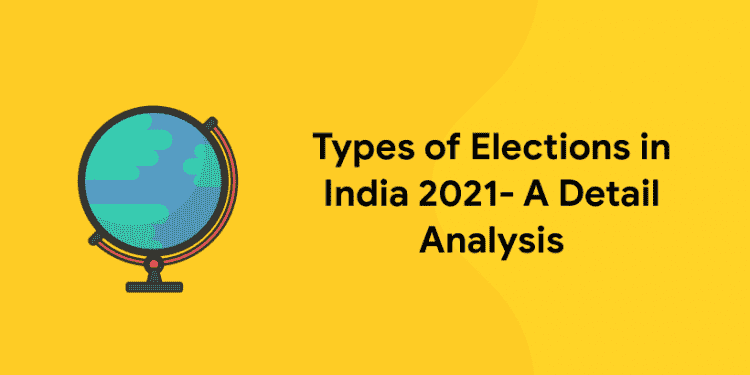Table of Contents
“We the people of India have solemnly resolved to constitute India into a Sovereign Socialist Secular Democratic Republic and……” This is how our Preamble of the Constitution of India starts. India the nation constituted to be a democratic in its political form according to the fundamental law of land. The general elections in India conducted once in 5 years is the fundamental expression of the democratic powers entrusted to the people of India. So, in that sense, to know the types of elections in India is to know the democratic powers entrusted to the people of India. elections are not only the expression of democracy but nowadays elections in India are becoming the only expression of democracy. In order to know the political functions of the Indian nation, the democratic system of the state, and to know the ruling system of the country we need to understand the elections in India. Let us look into the various types of elections in India.
Read About Indian President List and Vice President List
Elections in India: Various Types of Elections in India
There are a lot of elections in India like the school leader election. Because everywhere the elections are conducted just because the nation is deep rooted in the idea of democracy. But can we consider all these elections as general elections in India? absolutely not. General elections in India are considered to be the elections in India that are conducted to select the representative to different offices. All other elections are elections with serious concern but are not considered as a general election. As per the constitution of India the general elections in India are the elections conducted by the Elections commission of India. It can be the central election commission or the state election commission. Let us look into the broad classification of various kinds of election in India.
- Local Self Government elections in India
- Legislative assembly elections in India
- Legislative Council elections in India
- Parliamentary Elections in India
- President and Vice President Elections in India
Local Self Government Elections in India
1: Who was the first woman President of India?
Mahatma Gandhi has once said the heart of the nations will be found in the villages of the nation. By understanding the vision of Mahatma Gandhi, the constitution of India has formed a system of local self-government. In India there prevails a federal system of government. We have a centre as well as state. We have a power decentralisation as central government and state government. In order to increase the efficiency of the governance the state governments governing power has further be decentralised to local self-government. The local self-government consists of a three tier panchayat system. That is Grama Panchayath, Block Panchayath and district Panchayath. These systems can be changed in different parts of the country as khap panchayats etc gaining influence from their tradition and history. In Kerala there is a three-tier structure as Grama Panchayath, Block Panchayath, District Panchayath and free and fair elections are conducted once in 5 years to these government. The elections to the three-tier system are conducted in a single day by the state election commission of India. a person will have three votes to cast for their representative towards grama panchayath block Panchayat and District panchayath. This kind of local self-government elections is important election in India.
The elections are conducted on the principle of First -Past-First-Post-System. Which means the person who secures the greatest number of votes in total will be declared as the elected representative. There is no other quorum or transferring of votes involved in this phase. This system of election in India is very simple and based on the simple principle that whoever secures the greatest number of votes will be the elected one.
Free UPSKILLING Courses!
Take your first step toward mastering in-demand skills, acing interviews, and securing top-tier jobs with Entri's free upskilling courses.
Start Learning!Legislative Assembly in election in India
There are 28 states in India as of now. In each state there will be a legislature which is entrusted to carry out the function of legislation in the state. Legislative is the body consisting of the elected members of the people representing a particular geographical area called assembly constituency in the state. The elections conducted in India conducted towards the election of the members of legislative assembly (MLA) is considered as one of the most important elections in India. The elections are conducted by the Election commission of India (ECI). The tenure of the legislative assembly is 5 years and the legislative assembly elections in India will be conducted once in 5 years. This is also based on the First -Past-First-Post-System. Whoever secures the greatest number of votes will be elected. The state cabinet is formed from the elected members of the legislature in the case where the state has only legislative assembly and no legislative council. In the case of Kerala, the state has only a legislative assembly and the state cabinet is formed from the elected members of the legislative assembly.
Enroll Entri for Latest Updates of General Knowledge
Legislative Council Elections in India
Legislative council of states is an upper body to the legislative assembly same as that in the case of Lok Sabha and Rajya Sabha. Legislative assembly and legislative council will constitute bicameral legislation in the state as that of the centre. But the constitution of India gives the freedom to the states to form a legislative council if they insist. They are not mandatory. There are only some states which have legislative councils. For Kerala there is no legislative council but Andhra Pradesh, Karnataka, Telangana, Maharashtra, Bihar, and Uttar Pradesh and Telangana have legislative councils for the states.
Enroll Entri for Latest Updates of General Knowledge
The constitution talks about the strength and the manner of legislative council elections in India. The maximum number of members of the legislative council is set to be 1/3rd of the members of the legislative assembly and the minimum number is said to be 40. The election towards the legislative council is an indirect election. The strength of the legislative council is set in such a way that the dominance of the directly elected legislative assembly should not be lowered. The election is based on proportional representation by means of a single transferable vote. Manner of legislative council elections in India is described below.
- 1/3rd is elected by the members of the local self-government
- 1/12 are selected by the graduates of three years standing and residing in the state
- 1/12 are selected by the teachers of three years standing and residing in the state but not lower than secondary school level
- 1/3 is elected by the members of the state legislative assembly not among its members
- The remaining members are nominated by the governor having special knowledge or practical expertise in various fields like literature, science, art etc.
Parliamentary Elections in India
The Parliament of India is composed of two bodies : the lower house/ House of the common/Lok Sabha and the other is the Upper House/House of the People/Rajyasabha. This is a bicameral legislative body. Every act or law to be passed in the parliament should be approved by both of the houses on some majority depending upon the nature of the bill presented.
Lok Sabha Election in India
Lok Sabha elections in India are conducted once in 5 years in every state of the nation. The state has been distinguished from a separate geographical area to find the representative of the parliament for that area in the state. The classification is called parliamentary constituencies of the state. The parliamentary constituencies are designed in such a way that the ratio or the proportion of the elected members of the parliament from the state and the population of the state should remain the same. The election is based on the principle of First -Past-First-Post-System. Whoever secures the greatest number of votes will be elected as the Member of Parliament (MP) towards the Lok Sabha. 2 of the members of the Lok Sabha is nominated by the President of India from the Anglo-Indian Community. But the nomination is subjected to change recently.
Rajya Sabha Elections in India
Rajya Sabha is a permanent body which is not subject to dissolution. The members of the Rajya Sabha will retire once in every three year. The constitution doesn’t say about the tenure of the members of the Rajya Sabha but the Representation of the Peoples Act says the members of the Rajya Sabha have 6 years of tenure. The retired members of the Rajya Sabha are eligible for re-election and appointment as members. The Rajya Sabha Election is done in Indirect election and the principle involved in Proportional Election by means of single transferable votes and the nomination of the President.
Enroll Entri for Latest Updates of General Knowledge
Free UPSKILLING Courses!
Take your first step toward mastering in-demand skills, acing interviews, and securing top-tier jobs with Entri's free upskilling courses.
Start Learning!President and Vice President Election in India
The President is the first citizen of India and is the head of the executive of the state. The election procedure of the President is mentioned in detail in the constitution as per Article 52 to 78 in Part V. The President is elected not directly by the people but by members of the electoral college consisting of:
- The elected members of both the house of the Parliament
- The elected members of the legislative assemblies of the state
- The elected members of the legislative assemblies of union territories Delhi Puducherry (In the case Jammu and Kashmir should be updated soon)
The Vote Share of the one vote of the following members will be like this
| Value of Vote | Formula |
| Value of Vote of an MLA | {Total Population of the state/ Total number of elected members of the state legislative assembly} * 1/1000 |
| Value of Vote of an MP | Total value of votes of all MLA of all states/ Total Members of the elected members of the parliament |
The presidential election in India is done as per the Proportional Representation by means of a single transferable system. The system should have definite electoral quota as per the following equation:
Electoral Quota = {Total number of valid votes polled / 1+1=2} + 1
The procedure of President election in India is as follows:
- Each member of the electoral college is given a secret ballot paper. They can indicate the preference of the presidential candidates b y marking 1,2,3,4 and so on…
- In the first phase the first preference is counted and in case if candidates secures the minimum electoral quota he will be declared as the President of India.
- In case in the first phase no one secures the minimum electoral quota as said above, the candidate who secured minimum votes in the first phase got cancelled and the second preference of those ballot papers will be added to the first phase and then compared to check anyone attained the minimum electoral quota.
- The procedure will be repeated until a candidate secures minimum electoral quota as said above.
Vice President Election in India
The Vice President Election in India is conducted as same as that of the manner prescribed for the President election in India. but the electoral college for the Vice President in election in India is having a slight change as that of President Election in India. It is as follows:
- It consists of both the elected and nominated members of the Parliament
- It does not include the members of the state legislative assemblies.
The other procedure and manner for the Vice President of election in India are same as that of the president election in India.
Enroll Entri for Latest Updates of General Knowledge
Conclusion
As said in the introduction, to know the types and manner of elections in India is to know the democratic existence of ourselves in the political structure of the nation. Let us hope some of the people who read this blog may become those elected members of any office by the general elections in India. If the persons who are not willing to get elected in the general elections in India, study very well about the manner and types of the elections in India to crack any competitive exams to hold a respectable position. Enroll Entri for more general knowledge updates. Keep studying, Keep winning!













